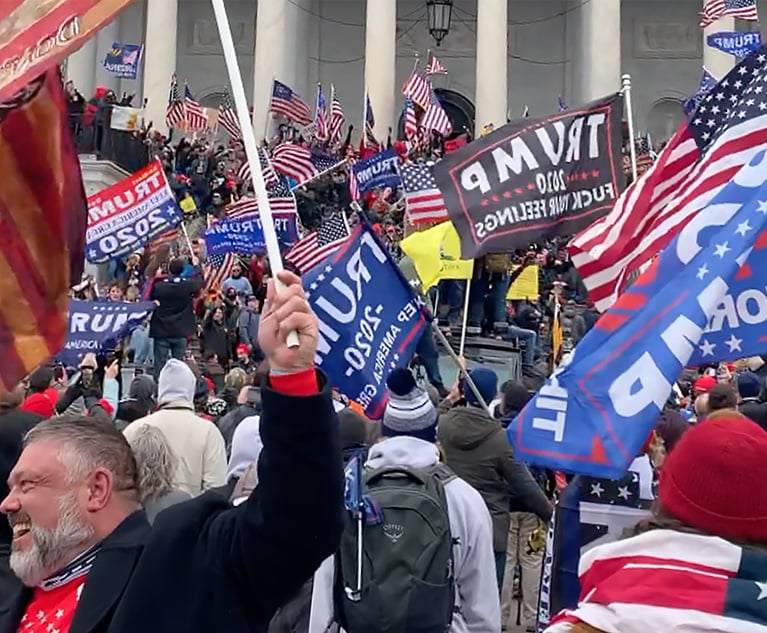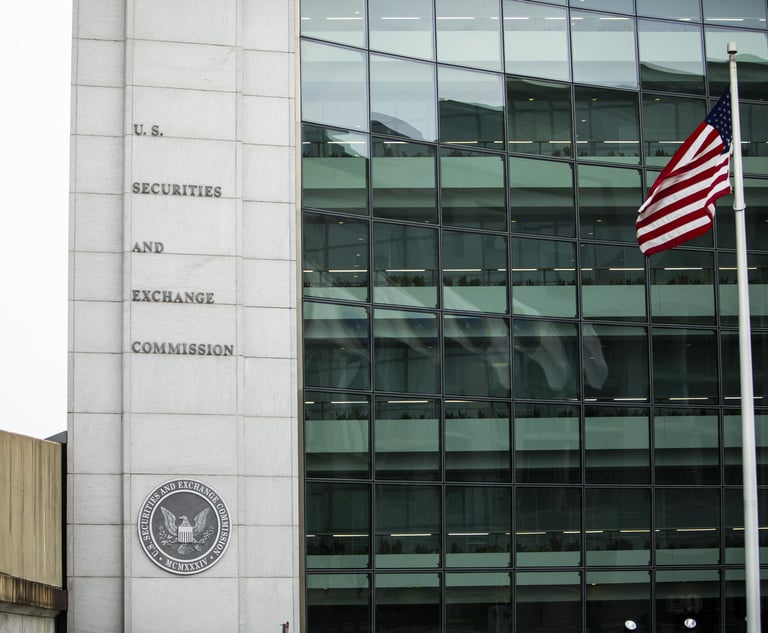Securing the Testimony of a Witness in Government Custody
Practitioners in need of trial or deposition testimony (in either a state or federal civil case) of a witness in a government custody should consider seeking a Writ in federal court to obtain same.
March 04, 2019 at 02:30 PM
8 minute read

There are several scenarios under which counsel may find themselves in need of trial or deposition testimony in a civil case of a witness that is currently in government custody. In the area of parallel civil and criminal actions, for example, the civil action must often take a back seat to the criminal proceedings, with discovery and trial proceeding only after resolution of the criminal proceedings. In such a case, counsel may find that an important witness for the civil action is in government custody at the time of trial or when the time comes to take that witness' deposition. A further—and perhaps more precarious—example is when counsel is in need of the testimony of a witness who is in the custody of U.S. Immigration and Customs Enforcement (ICE). While the deposition of a party witness in government custody can sometimes proceed by way of notice and be held at the facility where the witness is in custody, this is not the case where testimony must be secured by way of a subpoena, as a subpoena is ordinarily ineffective to compel an individual in government custody to testify. See, e.g., Sec. Investor Prot. v. Bernard L. Madoff Inv. Sec., 496 B.R. 713, 722-723 (Bankr. S.D.N.Y. 2013) (citing U.S. v. Gotti, 784 F. Supp. 1011, 1012 (E.D.N.Y. 1992) (“The reason for the distinction is that a subpoena commands the prospective witness to attend, whereas the writ ad testificandum commands the custodian of the potential witness to produce him”). With regard to both party and non-party depositions, a further wrinkle might be added to the scenario where the witness is in ICE custody, as the whereabouts of that witness may not be readily ascertainable.
In such situations, an effective means for securing the testimony of a witness in government custody is a writ of habeas corpus ad testificandum (the Writ). The procedure for seeking the Writ, and availability of such a remedy in state courts, will vary based on jurisdiction. In New York, for example, the Writ is only statutorily available to secure testimony in criminal proceedings, and more generally, the CPLR limits those who can bring a special habeas corpus proceeding to “[a] person illegally imprisoned or otherwise restrained in his liberty within the state, or one acting on his behalf or a party in a child abuse proceeding subsequent to an order of the family court.” See CPL §650.30; CPLR §7002. Thus, the most effective way to seek the Writ will often be by way of a petition to a federal district court. The petition does not necessarily need to be made in the court where the action is pending (i.e., it can be sought in an ancillary proceeding), as the Writ is directed toward the custodian of the witness and not the witness him-or herself. Atkins v. City of New York, 856 F. Supp. 755, 757 (E.D.N.Y. 1994) (“The purpose of this writ is to direct the custodian of a prisoner to produce such prisoner for appearance in court”). In other words, while the Writ would ideally be sought in the federal court within the jurisdiction where the custodian is located, the Writ can be issued by a federal court extraterritorially. ITEL Capital v. Dennis Mining Supply & Equipment, 651 F.2d 405, 407 (5th Cir. 1981); Atkins, 856 F. Supp. at 758 (“prevailing view of the appellate courts favors the extraterritorial application of a writ of habeas corpus ad testificandum in appropriate circumstances”); but see Gabriel Mills v. Fenger, 2008 U.S. Dist. LEXIS 44061, *9, 2008 WL 2357619 (W.D.N.Y. June 4, 2008) (where Writ was sought for purposes of attendance at a settlement conference, “[t]he proper way to obtain this writ (if it is indeed available for the purposes intended by the parties) is to apply to the United States District Court … where the custodian of plaintiff resides, for the writ in an ancillary proceeding”).
A federal court's authority to issue the Writ is derived from a reading of 28 U.S.C. §2241(c)(5), which empowers federal courts to grant a writ of habeas corpus where “[i]t is necessary to bring [an individual in government custody] into court to testify or for trial; in tandem with 28 U.S.C. §1651(a), the “All Writs Act,” which empowers a federal court to “issue all writs necessary or appropriate in aid of their respective jurisdictions and agreeable to the usages and principles of law.” Atkins, 856 F. Supp. at 757. A federal court's power to issue the Writ has specifically been held to apply to pre-trial oral depositions of non-party prisoner witnesses in civil cases. See, e.g., Calvente v. Suffolk Cnty. Corr. Facility, 2017 U.S. Dist. LEXIS 75472, *2-3 (E.D.N.Y. May 16, 2017) (court issued a writ to the Superintendent of the Marcy Correctional Facility to have a prisoner delivered to Sing Sing Correctional Facility to sit for a deposition); Waste Mgmt. of La. v. River Birch, 2017 U.S. Dist. LEXIS 58842, *8-10, 2017 WL 1383710 (E.D. La. April 13, 2017) (“The Court may also issue a Writ of Habeas Corpus Ad Testificandum for the purpose of taking an oral deposition”); In re Rothstein Rosenfeldt Adler, P.A., No. 11-61338, 2011 U.S. Dist. LEXIS 99651, 2011 WL 3903567 (S.D. Fla Sept. 6, 2011) (discussing issuance of such a Writ for pretrial deposition). The Writ has also been used to direct federal immigration officials to produce subject witnesses in their custody. See, e.g., Rangolan v. County of Nassau, 370 F.3d 239, 249 (2d Cir. 2004); United States v. Seijo, 595 F.2d 116, 118 (2d Cir. 1979).
The “decision to issue a writ of habeas corpus ad testificandum is committed to the sound discretion of the district court.” Atkins, 856 F. Supp. at 757. The “factors that a court should consider in exercising this discretion include: (1) whether the prisoner's presence will substantially further the resolution of the case, (2) the security risks presented by the prisoner's transportation and safekeeping, and (3) whether the suit can be stayed until the prisoner is released without prejudice to the cause asserted.” Id.
For example, in Atkins v. City of New York, 856 F. Supp. 755 (E.D.N.Y. 1994), a civil rights action brought against the City of New York alleging wrongful arrest and police brutality, the defendants sought a Writ for the production of a non-party witness incarcerated in a state prison in New Jersey to testify at trial. Id. at 756. The witness in that case was believed by the defendants to be an eye witness who could rebut the claimed lack of probable cause for the underlying arrest. The Writ also sought to have the witness temporarily detained at the Metropolitan Correctional Facility in Manhattan until such time as the court directed that the Writ had been satisfied. Id. In granting the petition for the Writ, the court first noted that the witness would be incarcerated for another two years, had not committed an offense involving physical violence, and that defendants would bear all associated costs (thereby satisfying last two considerations). Id. at 757. With regard to the first consideration—whether the prisoner's presence will substantially further the resolution of the case—the court opined that “[t]he cogent question … is not merely whether [the witness'] expected testimony would be relevant, but rather, whether such testimony is necessary.” This determination “depends ultimately upon whether the probative value of the testimony justifies the expense and security risk associated with transporting an inmate to court from a correctional facility.” Id. at 758. The court held that the testimony of an eye witness of the incident in question would “appear to be pivotal” and therefore granted the application for the Writ. Id.
Thus, practitioners in need of trial or deposition testimony (in either a state or federal civil case) of a witness in a government custody should consider seeking a Writ in federal court to obtain same. Counsel should be mindful that the Writ will likely only be issued to secure the testimony of key witnesses, and should therefore be guided by their own judgment as to whether the witness is truly “necessary” to the defense or prosecution of their case. Moreover, counsel should be prepared to bear all costs associated with the transportation, temporary detention and production of the witness. One should, of course, consult the local rules of the jurisdiction where the action is pending to determine if there is an established or streamlined procedure to accomplish this in the court where the action is pending. In the absence of such a procedure, like in New York, the best option will likely be to seek the Writ in an ancillary proceeding in federal district court.
Jack A. Gordon is the managing partner of Kent, Beatty & Gordon, where he also heads the firm's litigation and hospitality practices. Alex T. Paradiso is a senior associate in the firm's litigation and arbitration practice group.
This content has been archived. It is available through our partners, LexisNexis® and Bloomberg Law.
To view this content, please continue to their sites.
Not a Lexis Subscriber?
Subscribe Now
Not a Bloomberg Law Subscriber?
Subscribe Now
NOT FOR REPRINT
© 2025 ALM Global, LLC, All Rights Reserved. Request academic re-use from www.copyright.com. All other uses, submit a request to [email protected]. For more information visit Asset & Logo Licensing.
You Might Like
View All
Private Equity Giant KKR Refiles SDNY Countersuit in DOJ Premerger Filing Row
3 minute readTrending Stories
Who Got The Work
J. Brugh Lower of Gibbons has entered an appearance for industrial equipment supplier Devco Corporation in a pending trademark infringement lawsuit. The suit, accusing the defendant of selling knock-off Graco products, was filed Dec. 18 in New Jersey District Court by Rivkin Radler on behalf of Graco Inc. and Graco Minnesota. The case, assigned to U.S. District Judge Zahid N. Quraishi, is 3:24-cv-11294, Graco Inc. et al v. Devco Corporation.
Who Got The Work
Rebecca Maller-Stein and Kent A. Yalowitz of Arnold & Porter Kaye Scholer have entered their appearances for Hanaco Venture Capital and its executives, Lior Prosor and David Frankel, in a pending securities lawsuit. The action, filed on Dec. 24 in New York Southern District Court by Zell, Aron & Co. on behalf of Goldeneye Advisors, accuses the defendants of negligently and fraudulently managing the plaintiff's $1 million investment. The case, assigned to U.S. District Judge Vernon S. Broderick, is 1:24-cv-09918, Goldeneye Advisors, LLC v. Hanaco Venture Capital, Ltd. et al.
Who Got The Work
Attorneys from A&O Shearman has stepped in as defense counsel for Toronto-Dominion Bank and other defendants in a pending securities class action. The suit, filed Dec. 11 in New York Southern District Court by Bleichmar Fonti & Auld, accuses the defendants of concealing the bank's 'pervasive' deficiencies in regards to its compliance with the Bank Secrecy Act and the quality of its anti-money laundering controls. The case, assigned to U.S. District Judge Arun Subramanian, is 1:24-cv-09445, Gonzalez v. The Toronto-Dominion Bank et al.
Who Got The Work
Crown Castle International, a Pennsylvania company providing shared communications infrastructure, has turned to Luke D. Wolf of Gordon Rees Scully Mansukhani to fend off a pending breach-of-contract lawsuit. The court action, filed Nov. 25 in Michigan Eastern District Court by Hooper Hathaway PC on behalf of The Town Residences LLC, accuses Crown Castle of failing to transfer approximately $30,000 in utility payments from T-Mobile in breach of a roof-top lease and assignment agreement. The case, assigned to U.S. District Judge Susan K. Declercq, is 2:24-cv-13131, The Town Residences LLC v. T-Mobile US, Inc. et al.
Who Got The Work
Wilfred P. Coronato and Daniel M. Schwartz of McCarter & English have stepped in as defense counsel to Electrolux Home Products Inc. in a pending product liability lawsuit. The court action, filed Nov. 26 in New York Eastern District Court by Poulos Lopiccolo PC and Nagel Rice LLP on behalf of David Stern, alleges that the defendant's refrigerators’ drawers and shelving repeatedly break and fall apart within months after purchase. The case, assigned to U.S. District Judge Joan M. Azrack, is 2:24-cv-08204, Stern v. Electrolux Home Products, Inc.
Featured Firms
Law Offices of Gary Martin Hays & Associates, P.C.
(470) 294-1674
Law Offices of Mark E. Salomone
(857) 444-6468
Smith & Hassler
(713) 739-1250









